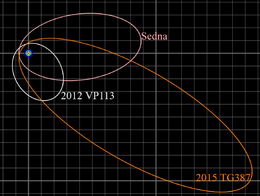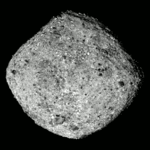Astronomy:(541132) 2015 TG387
 | |
| Discovery [1][2] | |
|---|---|
| Discovered by | D. J. Tholen C. Trujillo |
| Discovery site | Mauna Kea Obs. |
| Discovery date | 13 October 2015 |
| Designations | |
| (541132) 2015 TG387 | |
| V302126 [3] The Goblin [4][5] (mistaken for V774104 in 2015) | |
| Minor planet category | TNO [6] · sednoid [7][8] |
| Orbital characteristics [6] | |
| Epoch 27 April 2019 (JD 2458600.5) | |
| Uncertainty parameter 4 · 1 [1] | |
| Observation arc | 3.0 yr (1,100 d) |
| |{{{apsis}}}|helion}} | 1955±187 astronomical unit|AU |
| |{{{apsis}}}|helion}} | 65.08±0.21 AU |
| 1010±97 AU | |
| Eccentricity | 0.9356±0.006 |
| Orbital period | 32100±4600 yr |
| Mean anomaly | 359.34° |
| Mean motion | 0° 0m 0s / day |
| Inclination | 11.658° |
| Longitude of ascending node | 300.82° |
| 117.95° | |
| Physical characteristics | |
| Mean diameter | 300 km[7] 352 km[8] |
| Geometric albedo | 0.15 (assumed)[7] 0.09 (assumed)[8] |
| Apparent magnitude | 24.64[9] |
| Absolute magnitude (H) | 5.3[6] 5.5[1] |
(541132) 2015 TG387 (also known under its internal designation V302126,[3] nicknamed The Goblin for the letters TG and because its discovery was near Halloween),[10][4][5] is an extreme trans-Neptunian object and sednoid in the outermost part of the Solar System. It was first observed on 13 October 2015, by astronomers at the Mauna Kea Observatories, Hawaii. It has been the third sednoid discovery after Sedna and 2012 VP113, and measures approximately 350 kilometers (220 miles) in diameter.
Discovery
2015 TG387 was first observed on 13 October 2015 at the Mauna Kea Observatory (T09), by American astronomers David Tholen and Chad Trujillo during their astronomical survey for objects located beyond the Kuiper Cliff.[1][2] The unofficial discovery was publicly announced on 1 October 2018.[2][11] The survey uses two principal telescopes: For the Northern hemisphere, the 8.2-meter Subaru Telescope with its Hyper Suprime Camera at Mauna Kea Observatories, Hawaii, and for the Southern hemisphere, the 4-meter Blanco telescope and its Dark Energy Camera at Cerro Tololo Inter-American Observatory in Chile. For follow-up observations to determine an object's orbit, the astronomers are using the Magellan and the Discovery Channel telescopes. The survey's discoveries include 2012 VP113, 2014 SR349 and 2013 FT28.[7]
Orbit and classification
2015 TG387 orbits the Sun at a distance of 65–2000 astronomical unit|AU once roughly every 32,000 years (semi-major axis of ~1010 AU). Its orbit has an eccentricity of 0.94 and an inclination of 12° with respect to the ecliptic.[6] It belongs to the extreme trans-Neptunian objects defined by their large semi-major axis and is the third sednoid ever to be discovered, after Sedna and 2012 VP113 ("Biden").
Implications of orbit
Along with the similar orbits of other distant trans-Neptunian objects, the orbit of 2015 TG387 suggests, but does not prove, the existence of a hypothetical Planet Nine in the outer Solar System.[7][12]
(As of 2019), the object is inbound 78 AU from the Sun;[9] about two-and-a-half times farther out than Pluto's current location.[5] It will come to perihelion (closest approach to the Sun) in 2078.[6] As with Sedna, it would not have been found had it not been on the inner leg of its long orbit. This suggests that there may be many similar objects, most too distant to be detected by contemporary technological methods. Following the discovery of 2015 TG387, Sheppard et al. concluded that it implies a population of about 2 million inner Oort cloud objects larger than 40 km (25 mi), with a combined total mass of 1×1022 kg, which is several times the mass of the asteroid belt.[7]
Physical characteristics
The size of 2015 TG387 depends on the assumed albedo (reflectivity); if it is a darker object then it would also have to be larger; a higher albedo would demand that it be smaller.[13] The faint object has a visual magnitude of 24.64.[9] Its brightness was comparable to one of Pluto's smaller moons.[13] It is estimated by the discoverers to be 300 km (190 mi) in diameter, assuming an albedo of 0.15,[7] Johnston's archive calculates a diameter of 352 km based on an albedo of 0.09.[8]
Visualizations
-
Simulated view of Solar System as seen from 2015 TG387, showing the orbits of major planets and positions of other extreme trans-Neptunian objects.
-
View of 2015 TG387 from Earth, showing retrograde loops every year, with current position near γ Pegasi
Numbering and naming
This minor planet has been numbered by the Minor Planet Center on 10 October 2019 (M.P.C. 117077).[14] As of 2019, it has not been named.[1]
See also
- List of Solar System objects most distant from the Sun in 2018
- List of Solar System objects by greatest aphelion
References
- ↑ 1.0 1.1 1.2 1.3 1.4 "(541132) 2015 TG387". Minor Planet Center. https://www.minorplanetcenter.net/db_search/show_object?object_id=541132. Retrieved 21 October 2019.
- ↑ 2.0 2.1 2.2 "MPEC 2018-T05 : 2015 TG387". Minor Planet Electronic Circular. 1 October 2018. https://www.minorplanetcenter.net/mpec/K18/K18T05.html. Retrieved 13 December 2018.
- ↑ 3.0 3.1 Trujillo, C.; Sheppard, S.S.; Tholen, D.J.; Kaib, N. (October 24, 2018). "A New Inner Oort Cloud Object". 50th annual meeting of the AAS Division of Planetary Sciences. abstract 311.09. https://aas.org/meetings/dps50. Retrieved October 19, 2018.
- ↑ 4.0 4.1 Guarino, Ben (October 2, 2018). "New dwarf planet spotted at the very fringe of our solar system". The Washington Post. https://www.washingtonpost.com/science/2018/10/02/new-dwarf-planet-spotted-very-fringe-our-solar-system.
- ↑ 5.0 5.1 5.2 Chang, Kenneth (October 2, 2018). "A Goblin World That Points Toward Hidden Planet Nine in the Solar System". The New York Times. https://www.nytimes.com/2018/10/02/science/goblin-planet-nine.html.
- ↑ 6.0 6.1 6.2 6.3 6.4 "JPL Small-Body Database Browser: (2015 TG387)". Jet Propulsion Laboratory. https://ssd.jpl.nasa.gov/sbdb.cgi?sstr=3830896. Retrieved 13 December 2018.
- ↑ 7.0 7.1 7.2 7.3 7.4 7.5 7.6 Sheppard, Scott; Trujillo, Chadwick; Tholen, David; Kaib, Nathan (September 28, 2018). A New High Perihelion Inner Oort Cloud Object. doi:10.3847/1538-3881/ab0895.
- ↑ 8.0 8.1 8.2 8.3 Johnston, Wm. Robert (13 July 2019). "List of Known Trans-Neptunian Objects". Johnston's Archive. http://www.johnstonsarchive.net/astro/tnoslist.html. Retrieved 21 October 2019.
- ↑ 9.0 9.1 9.2 "2015 TG387 – Ephemerides". AstDyS-2, Asteroids – Dynamic Site, Department of Mathematics, University of Pisa, Italy. https://newton.spacedys.com/astdys/index.php?pc=1.1.3.0&n=2015TG387. Retrieved 12 December 2018.
- ↑ The Goblin 101: New Dwarf Planet 2015 TG387 Scott Sheppard, an astronomer at Carnegie's Department of Terrestrial Magnetism, introduces newly found dwarf planet 2015 TG387. Nicknamed "the Goblin," this new extremely distant object has an orbit that strengthens the case for the existence of a still undiscovered Planet X.
- ↑ Mortillaro, Nicole (October 2, 2018). "Discovery of new object supports theory of 'super-Earth' at edge of solar system". CBC News. https://www.cbc.ca/news/technology/planet-nine-tg387-1.4845760.
- ↑ Witze, Alexandra (October 1, 2018). "'Goblin' world found orbiting at the edges of the Solar System". Nature. doi:10.1038/d41586-018-06885-1. https://www.nature.com/articles/d41586-018-06885-1. Retrieved October 2, 2018.
- ↑ 13.0 13.1 Drake, Nadia (October 2, 2018). "New object beyond Pluto hints at mysterious 'Planet X'". National Geographic. https://www.nationalgeographic.com/science/2018/10/news-solar-system-object-pluto-planet-x-sun-space/.
- ↑ "MPC/MPO/MPS Archive". Minor Planet Center. https://www.minorplanetcenter.net/iau/ECS/MPCArchive/MPCArchive_TBL.html. Retrieved 21 October 2019.
External links
- List Of Centaurs and Scattered-Disk Objects, Minor Planet Center
- (541132) 2015 TG387 at AstDyS-2, Asteroids—Dynamic Site
- (541132) 2015 TG387 at the JPL Small-Body Database





